Sensorimotor Cortical Activity during Respiratory Arousals in Obstructive Sleep Apnea
Abstract
1. Introduction
2. Results
2.1. EEG-Based Markers
2.2. Association to Clinical Measures
2.3. Scientific Control
3. Discussion
4. Materials and Methods
4.1. Data Acquisition
4.2. Data Analysis
5. Conclusions
Author Contributions
Funding
Institutional Review Board Statement
Informed Consent Statement
Data Availability Statement
Conflicts of Interest
References
- Liang, J.; Zhang, X.; He, X.; Ling, L.; Zeng, C.; Luo, Y. The independent and combined effects of respiratory events and cortical arousals on the autonomic nervous system across sleep stages. Sleep Breath. 2018, 22, 1161–1168. [Google Scholar] [CrossRef] [PubMed]
- Remmers, J.E.; deGroot, W.J.; Sauerland, E.K.; Anch, A.M. Pathogenesis of upper airway occlusion during sleep. J. Appl. Physiol. Respir. Environ. Exerc Physiol. 1978, 44, 931–938. [Google Scholar] [CrossRef] [PubMed]
- Eckert, D.J.; Younes, M.K. Arousal from sleep: Implications for obstructive sleep apnea pathogenesis and treatment. J. Appl. Physiol. (1985) 2014, 116, 302–313. [Google Scholar] [CrossRef] [PubMed]
- Younes, M. Role of arousals in the pathogenesis of obstructive sleep apnea. Am. J. Respir. Crit Care Med. 2004, 169, 623–633. [Google Scholar] [CrossRef]
- Younes, M.; Loewen, A.H.; Ostrowski, M.; Laprairie, J.; Maturino, F.; Hanly, P.J. Genioglossus activity available via non-arousal mechanisms vs. that required for opening the airway in obstructive apnea patients. J. Appl. Physiol. (1985) 2012, 112, 249–258. [Google Scholar] [CrossRef]
- Younes, M.; Ostrowski, M.; Atkar, R.; Laprairie, J.; Siemens, A.; Hanly, P. Mechanisms of breathing instability in patients with obstructive sleep apnea. J. Appl. Physiol. (1985) 2007, 103, 1929–1941. [Google Scholar] [CrossRef]
- Loewen, A.; Ostrowski, M.; Laprairie, J.; Atkar, R.; Gnitecki, J.; Hanly, P.; Younes, M. Determinants of ventilatory instability in obstructive sleep apnea: Inherent or acquired? Sleep 2009, 32, 1355–1365. [Google Scholar] [CrossRef]
- Sands, S.A.; Terrill, P.I.; Edwards, B.A.; Taranto Montemurro, L.; Azarbarzin, A.; Marques, M.; de Melo, C.M.; Loring, S.H.; Butler, J.P.; White, D.P.; et al. Quantifying the Arousal Threshold Using Polysomnography in Obstructive Sleep Apnea. Sleep 2018, 41, zsx183. [Google Scholar] [CrossRef]
- Sforza, E.; Boudewijns, A.; Schnedecker, B.; Zamagni, M.; Krieger, J. Role of chemosensitivity in intrathoracic pressure changes during obstructive sleep apnea. Am. J. Respir. Crit Care Med. 1996, 154, 1741–1747. [Google Scholar] [CrossRef]
- Butler, M.P.; Emch, J.T.; Rueschman, M.; Sands, S.A.; Shea, S.A.; Wellman, A.; Redline, S. Apnea-Hypopnea Event Duration Predicts Mortality in Men and Women in the Sleep Heart Health Study. Am. J. Respir. Crit Care Med. 2019, 199, 903–912. [Google Scholar] [CrossRef]
- Lutsey, P.L.; McClelland, R.L.; Duprez, D.; Shea, S.; Shahar, E.; Nagayoshi, M.; Budoff, M.; Kaufman, J.D.; Redline, S. Objectively measured sleep characteristics and prevalence of coronary artery calcification: The Multi-Ethnic Study of Atherosclerosis Sleep study. Thorax 2015, 70, 880–887. [Google Scholar] [CrossRef]
- Zinchuk, A.V.; Jeon, S.; Koo, B.B.; Yan, X.; Bravata, D.M.; Qin, L.; Selim, B.J.; Strohl, K.P.; Redeker, N.S.; Concato, J.; et al. Polysomnographic phenotypes and their cardiovascular implications in obstructive sleep apnoea. Thorax 2018, 73, 472–480. [Google Scholar] [CrossRef]
- Redline, S.; Budhiraja, R.; Kapur, V.; Marcus, C.L.; Mateika, J.H.; Mehra, R.; Parthasarthy, S.; Somers, V.K.; Strohl, K.P.; Sulit, L.G.; et al. The scoring of respiratory events in sleep: Reliability and validity. J. Clin. Sleep Med. 2007, 3, 169–200. [Google Scholar] [CrossRef]
- Amatoury, J.; Azarbarzin, A.; Younes, M.; Jordan, A.S.; Wellman, A.; Eckert, D.J. Arousal Intensity is a Distinct Pathophysiological Trait in Obstructive Sleep Apnea. Sleep 2016, 39, 2091–2100. [Google Scholar] [CrossRef]
- Bahr, K.; Geisler, V.; Huppertz, T.; Groppa, S.; Matthias, C.; Gouveris, H.; Muthuraman, M. Intensity of Respiratory Cortical Arousals Is a Distinct Pathophysiologic Feature and Is Associated with Disease Severity in Obstructive Sleep Apnea Patients. Brain Sci. 2021, 11, 282. [Google Scholar] [CrossRef]
- Bein, B. Entropy. Best. Pract. Res. Clin. Anaesthesiol. 2006, 20, 101–109. [Google Scholar] [CrossRef]
- Gao, X.; Yan, X.; Gao, P.; Gao, X.; Zhang, S. Automatic detection of epileptic seizure based on approximate entropy, recurrence quantification analysis and convolutional neural networks. Artif. Intell Med. 2020, 102, 101711. [Google Scholar] [CrossRef]
- Liu, A.-B.; Lin, C.-W. Multiscale Approximate Entropy for Gait Analysis in Patients with Neurodegenerative Diseases. Entropy 2019, 21, 934. [Google Scholar] [CrossRef]
- Wang, Y.; Ji, S.; Yang, T.; Wang, X.; Wang, H.; Zhao, X. An Efficient Method to Detect Sleep Hypopnea- Apnea Events Based on EEG Signals. IEEE Access 2021, 9, 641–650. [Google Scholar] [CrossRef]
- Ohisa, N.; Ogawa, H.; Murayama, N.; Yoshida, K. A novel EEG index for evaluating the sleep quality in patients with obstructive sleep apnea-hypopnea syndrome. Tohoku J. Exp. Med. 2011, 223, 285–289. [Google Scholar] [CrossRef][Green Version]
- Kaimakamis, E.; Tsara, V.; Bratsas, C.; Sichletidis, L.; Karvounis, C.; Maglaveras, N. Evaluation of a Decision Support System for Obstructive Sleep Apnea with Nonlinear Analysis of Respiratory Signals. PLoS ONE 2016, 11, e0150163. [Google Scholar] [CrossRef] [PubMed]
- Helakari, H.; Kananen, J.; Huotari, N.; Raitamaa, L.; Tuovinen, T.; Borchardt, V.; Rasila, A.; Raatikainen, V.; Starck, T.; Hautaniemi, T.; et al. Spectral entropy indicates electrophysiological and hemodynamic changes in drug-resistant epilepsy—A multimodal MREG study. Neuroimage Clin. 2019, 22, 101763. [Google Scholar] [CrossRef]
- Urigüen, J.A.; García-Zapirain, B.; Artieda, J.; Iriarte, J.; Valencia, M. Comparison of background EEG activity of different groups of patients with idiopathic epilepsy using Shannon spectral entropy and cluster-based permutation statistical testing. PLoS ONE 2017, 12, e0184044. [Google Scholar] [CrossRef] [PubMed]
- Maturana-Candelas, A.; Gómez, C.; Poza, J.; Ruiz-Gómez, S.J.; Núñez, P.; Rodríguez, M.; Figueruelo, M.; Pita, C.; Pinto, N.; Martins, S.; et al. Analysis of Spontaneous EEG Activity in Alzheimer’s Disease Patients by Means of Multiscale Spectral Entropy. In Converging Clinical and Engineering Research on Neurorehabilitation III; Springer International Publishing: Cham, Switzerland, 2019; pp. 579–583. [Google Scholar]
- Li, X.; Li, D.; Liang, Z.; Voss, L.J.; Sleigh, J.W. Analysis of depth of anesthesia with Hilbert-Huang spectral entropy. Clin. Neurophysiol. 2008, 119, 2465–2475. [Google Scholar] [CrossRef] [PubMed]
- Maksimow, A.; Särkelä, M.; Långsjö, J.W.; Salmi, E.; Kaisti, K.K.; Yli-Hankala, A.; Hinkka-Yli-Salomäki, S.; Scheinin, H.; Jääskeläinen, S.K. Increase in high frequency EEG activity explains the poor performance of EEG spectral entropy monitor during S-ketamine anesthesia. Clin. Neurophysiol. 2006, 117, 1660–1668. [Google Scholar] [CrossRef]
- Gouveris, H.; Bahr, K.; Schmitt, E.; Abriani, A.; Boekstegers, T.; Fassnacht, S.; Huppertz, T.; Groppa, S.; Muthuraman, M. Corticoperipheral neuromuscular disconnection in obstructive sleep apnoea. Brain Commun. 2020, 2, fcaa056. [Google Scholar] [CrossRef]
- Ayas, N.T.; Hirsch, A.A.; Laher, I.; Bradley, T.D.; Malhotra, A.; Polotsky, V.Y.; Tasali, E. New frontiers in obstructive sleep apnoea. Clin. Sci. 2014, 127, 209–216. [Google Scholar] [CrossRef]
- D’Rozario, A.L.; Cross, N.E.; Vakulin, A.; Bartlett, D.J.; Wong, K.K.H.; Wang, D.; Grunstein, R.R. Quantitative electroencephalogram measures in adult obstructive sleep apnea—Potential biomarkers of neurobehavioural functioning. Sleep Med. Rev. 2017, 36, 29–42. [Google Scholar] [CrossRef]
- Mazzotti, D.R.; Lim, D.C.; Sutherland, K.; Bittencourt, L.; Mindel, J.W.; Magalang, U.; Pack, A.I.; de Chazal, P.; Penzel, T. Opportunities for utilizing polysomnography signals to characterize obstructive sleep apnea subtypes and severity. Physiol. Meas 2018, 39, 09tr01. [Google Scholar] [CrossRef]
- Vakulin, A.; D’Rozario, A.; Kim, J.W.; Watson, B.; Cross, N.; Wang, D.; Coeytaux, A.; Bartlett, D.; Wong, K.; Grunstein, R. Quantitative sleep EEG and polysomnographic predictors of driving simulator performance in obstructive sleep apnea. Clin. Neurophysiol. 2016, 127, 1428–1435. [Google Scholar] [CrossRef]
- Xiromeritis, A.G.; Hatziefthimiou, A.A.; Hadjigeorgiou, G.M.; Gourgoulianis, K.I.; Anagnostopoulou, D.N.; Angelopoulos, N.V. Quantitative spectral analysis of vigilance EEG in patients with obstructive sleep apnoea syndrome: EEG mapping in OSAS patients. Sleep Breath 2011, 15, 121–128. [Google Scholar] [CrossRef]
- Azarbarzin, A.; Ostrowski, M.; Hanly, P.; Younes, M. Relationship between arousal intensity and heart rate response to arousal. Sleep 2014, 37, 645–653. [Google Scholar] [CrossRef]
- Terzano, M.G.; Mancia, D.; Salati, M.R.; Costani, G.; Decembrino, A.; Parrino, L. The cyclic alternating pattern as a physiologic component of normal NREM sleep. Sleep 1985, 8, 137–145. [Google Scholar] [CrossRef]
- Nguyen, C.D.; Wellman, A.; Jordan, A.S.; Eckert, D.J. Mild Airflow Limitation during N2 Sleep Increases K-complex Frequency and Slows Electroencephalographic Activity. Sleep 2016, 39, 541–550. [Google Scholar] [CrossRef]
- Saunamäki, T.; Huupponen, E.; Loponen, J.; Himanen, S.L. CPAP Treatment Partly Normalizes Sleep Spindle Features in Obstructive Sleep Apnea. Sleep Disord 2017, 2017, 2962479. [Google Scholar] [CrossRef]
- Younes, M.; Hanly, P.J. Immediate postarousal sleep dynamics: An important determinant of sleep stability in obstructive sleep apnea. J. Appl. Physiol. (1985) 2016, 120, 801–808. [Google Scholar] [CrossRef]
- Liang, Z.; Wang, Y.; Sun, X.; Li, D.; Voss, L.J.; Sleigh, J.W.; Hagihira, S.; Li, X. EEG entropy measures in anesthesia. Front. Comput. Neurosci. 2015, 9, 16. [Google Scholar] [CrossRef]
- Pincus, S.M. Approximate entropy as a measure of system complexity. Proc. Natl. Acad. Sci. USA 1991, 88, 2297–2301. [Google Scholar] [CrossRef]
- Sammer, G. Working-memory load and dimensional complexity of the EEG. Int. J. Psychophysiol. 1996, 24, 173–182. [Google Scholar] [CrossRef]
- Gutiérrez-Tobal, G.C.; Gomez-Pilar, J.; Kheirandish-Gozal, L.; Martín-Montero, A.; Poza, J.; Álvarez, D.; Del Campo, F.; Gozal, D.; Hornero, R. Pediatric Sleep Apnea: The Overnight Electroencephalogram as a Phenotypic Biomarker. Front. Neurosci. 2021, 15, 644697. [Google Scholar] [CrossRef]
- Burioka, N.; Miyata, M.; Cornélissen, G.; Halberg, F.; Takeshima, T.; Kaplan, D.T.; Suyama, H.; Endo, M.; Maegaki, Y.; Nomura, T.; et al. Approximate entropy in the electroencephalogram during wake and sleep. Clin. EEG Neurosci. 2005, 36, 21–24. [Google Scholar] [CrossRef] [PubMed]
- Liu, J.; Huang, R.; Xiao, Y.; Lin, S. ApEn for assessing hypoxemia severity in obstructive sleep apnea hypopnea syndrome patients. Sleep Breath 2020, 24, 1481–1486. [Google Scholar] [CrossRef] [PubMed]
- Liang, D.; Wu, S.; Tang, L.; Feng, K.; Liu, G. Short-Term HRV Analysis Using Nonparametric Sample Entropy for Obstructive Sleep Apnea. Entropy 2021, 23, 267. [Google Scholar] [CrossRef]
- Sharma, M.; Yadav, A.; Tiwari, J.; Karabatak, M.; Yildirim, O.; Acharya, U.R. An Automated Wavelet-Based Sleep Scoring Model Using EEG, EMG, and EOG Signals with More Than 8000 Subjects. Int. J. Environ. Res. Public Health 2022, 19, 7176. [Google Scholar] [CrossRef]
- Bruhn, J.; Röpcke, H.; Hoeft, A. Approximate entropy as an electroencephalographic measure of anesthetic drug effect during desflurane anesthesia. Anesthesiology 2000, 92, 715–726. [Google Scholar] [CrossRef] [PubMed]
- Berry, R.B.; Budhiraja, R.; Gottlieb, D.J.; Gozal, D.; Iber, C.; Kapur, V.K.; Marcus, C.L.; Mehra, R.; Parthasarathy, S.; Quan, S.F.; et al. Rules for scoring respiratory events in sleep: Update of the 2007 AASM Manual for the Scoring of Sleep and Associated Events. Deliberations of the Sleep Apnea Definitions Task Force of the American Academy of Sleep Medicine. J. Clin. Sleep Med. 2012, 8, 597–619. [Google Scholar] [CrossRef]
- Association, W.M. World Medical Association Declaration of Helsinki: Ethical Principles for Medical Research Involving Human Subjects. JAMA 2013, 310, 2191–2194. [Google Scholar] [CrossRef]
- McNicholas, W.T. Chronic obstructive pulmonary disease and obstructive sleep apnoea-the overlap syndrome. J. Thorac Dis. 2016, 8, 236–242. [Google Scholar] [CrossRef]
- Garcia-Rill, E. Neuroepigenetics of arousal: Gamma oscillations in the pedunculopontine nucleus. J. Neurosci Res. 2019, 97, 1515–1520. [Google Scholar] [CrossRef]
- Gouveris, H.; Selivanova, O.; Bausmer, U.; Goepel, B.; Mann, W. First-night-effect on polysomnographic respiratory sleep parameters in patients with sleep-disordered breathing and upper airway pathology. Eur. Arch Otorhinolaryngol. 2010, 267, 1449–1453. [Google Scholar] [CrossRef]
- Jurcak, V.; Tsuzuki, D.; Dan, I. 10/20, 10/10, and 10/5 systems revisited: Their validity as relative head-surface-based positioning systems. Neuroimage 2007, 34, 1600–1611. [Google Scholar] [CrossRef]
- WHO. Obesity: Preventing and Managing the Global Epidemic; WHO: Geneva, Switzerland, 2000. [Google Scholar]
- Baker, S.N. ‘Pooled coherence’ can overestimate the significance of coupling in the presence of inter-experiment variability. J. Neurosci. Methods 2000, 96, 171–172. [Google Scholar] [CrossRef]
- Hajian-Tilaki, K. Receiver Operating Characteristic (ROC) Curve Analysis for Medical Diagnostic Test Evaluation. Caspian J Intern Med. 2013, 4, 627–635. [Google Scholar] [PubMed]
- Inouye, T.; Shinosaki, K.; Sakamoto, H.; Toi, S.; Ukai, S.; Iyama, A.; Katsuda, Y.; Hirano, M. Quantification of EEG irregularity by use of the entropy of the power spectrum. Electroencephalogr. Clin. Neurophysiol. 1991, 79, 204–210. [Google Scholar] [CrossRef]
- Rezek, I.A.; Roberts, S.J. Stochastic complexity measures for physiological signal analysis. IEEE Trans. Biomed. Eng. 1998, 45, 1186–1191. [Google Scholar] [CrossRef]
- Gnoni, V.; Drakatos, P.; Higgins, S.; Duncan, I.; Wasserman, D.; Kabiljo, R.; Mutti, C.; Halasz, P.; Goadsby, P.J.; Leschziner, G.D.; et al. Cyclic alternating pattern in obstructive sleep apnea: A preliminary study. J. Sleep Res. 2021, 30, e13350. [Google Scholar] [CrossRef]
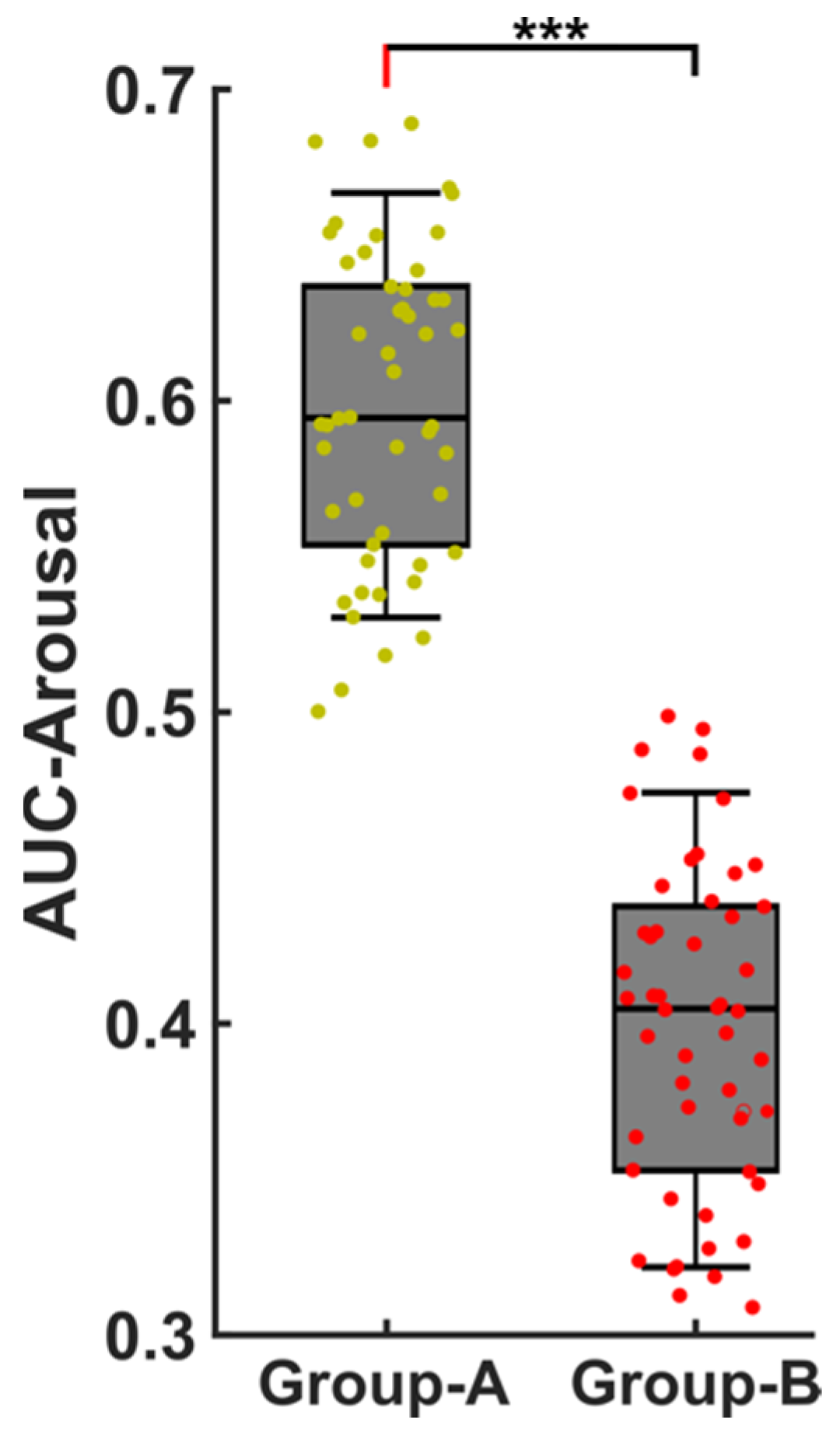
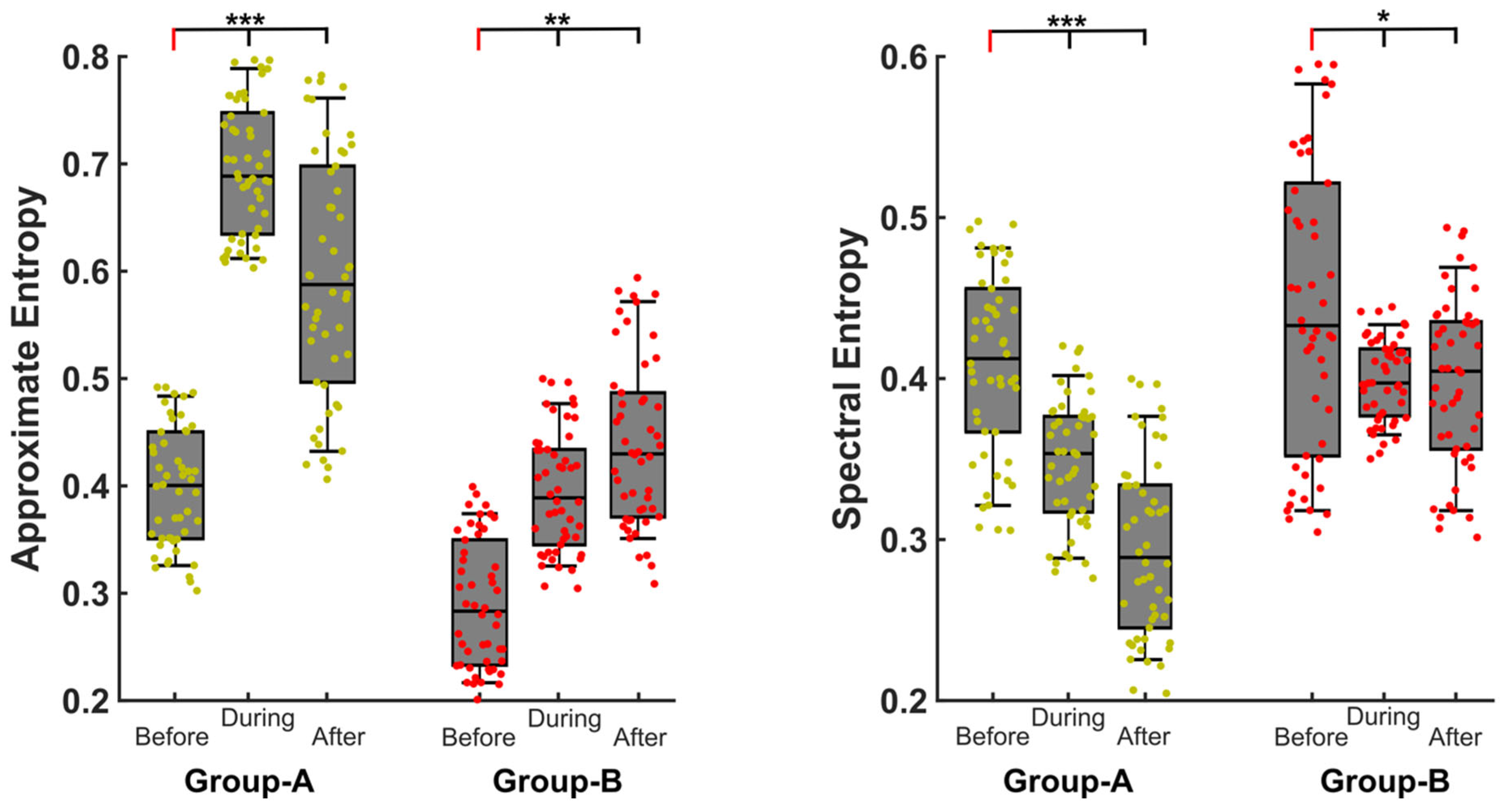
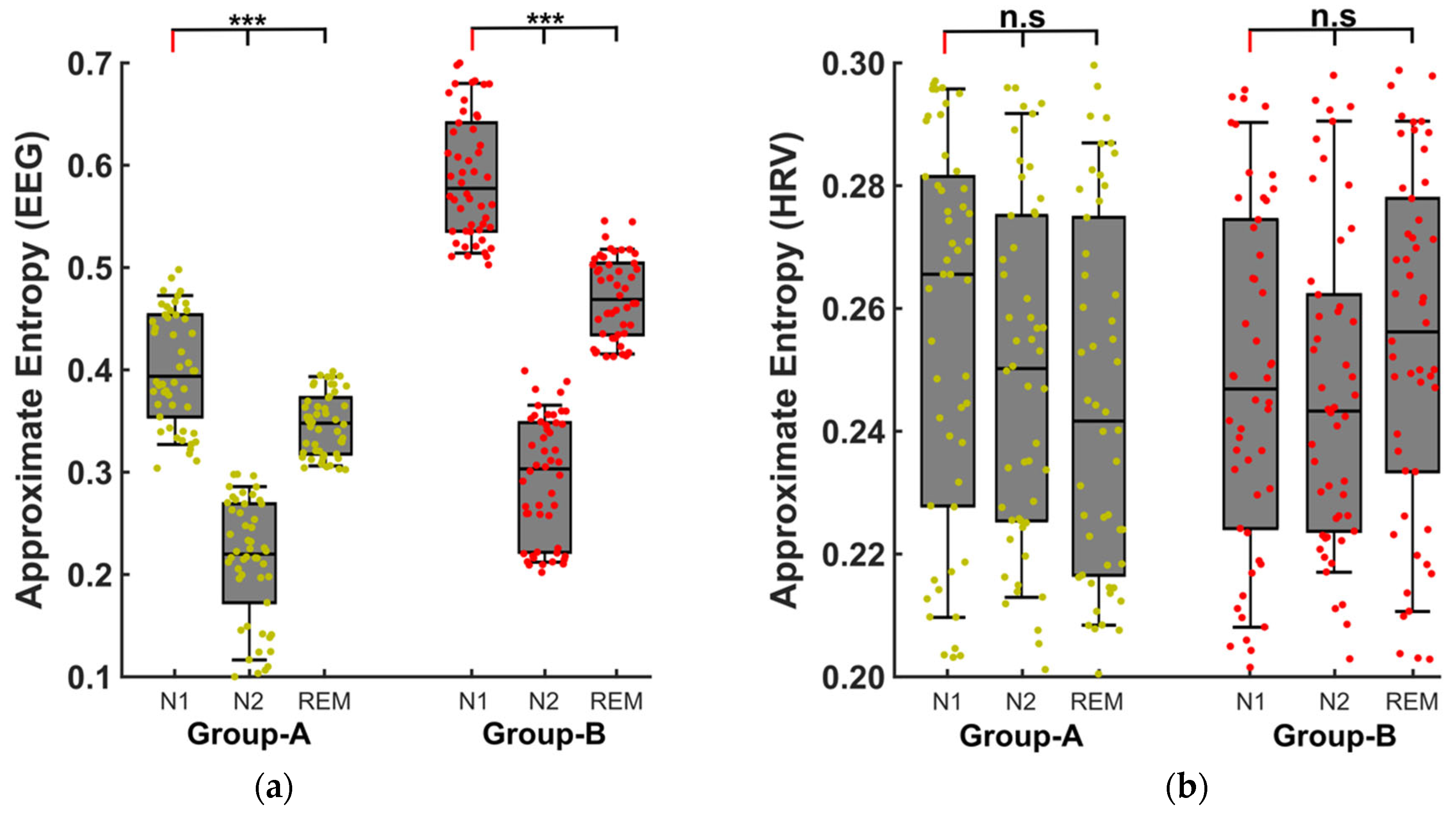
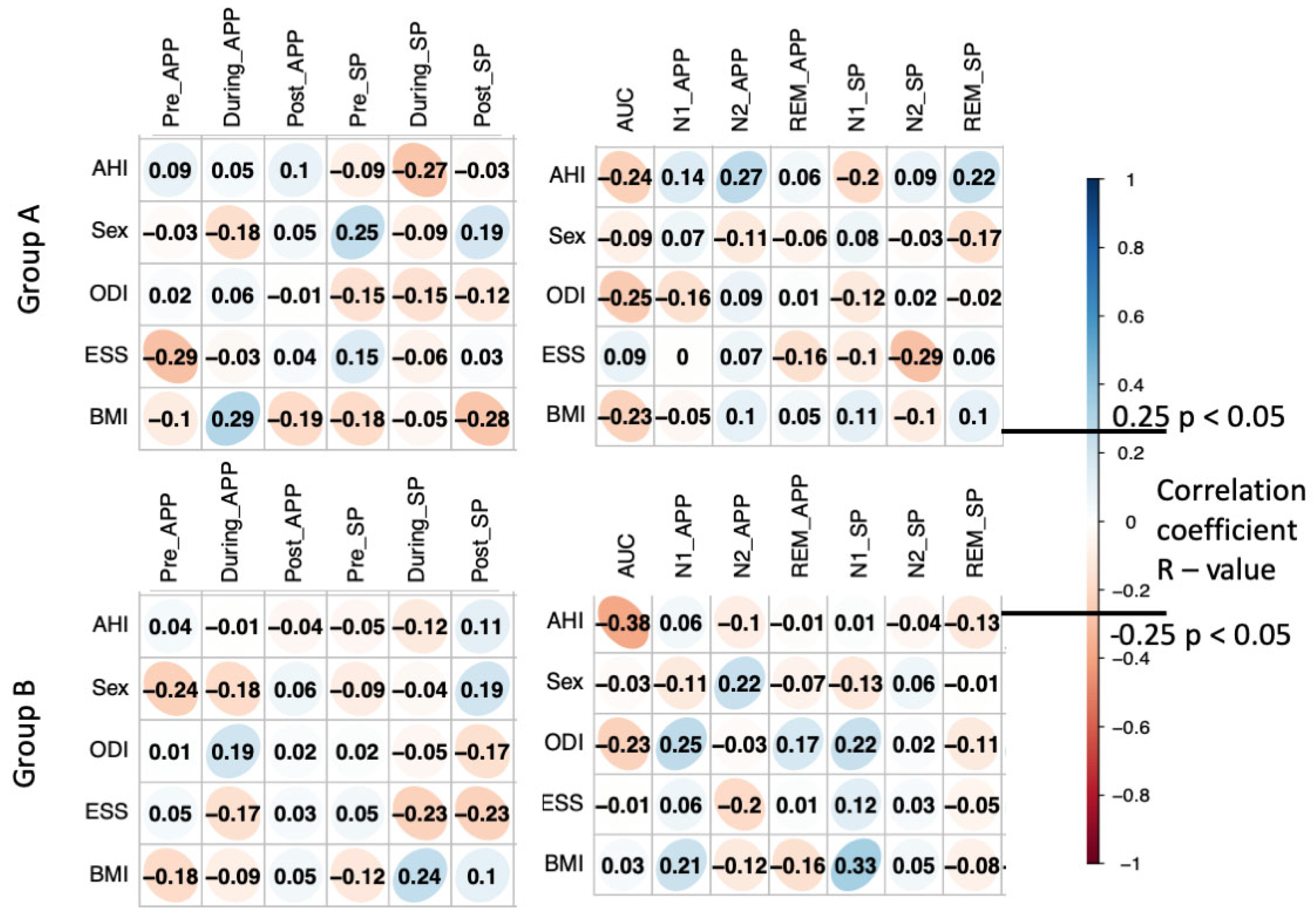
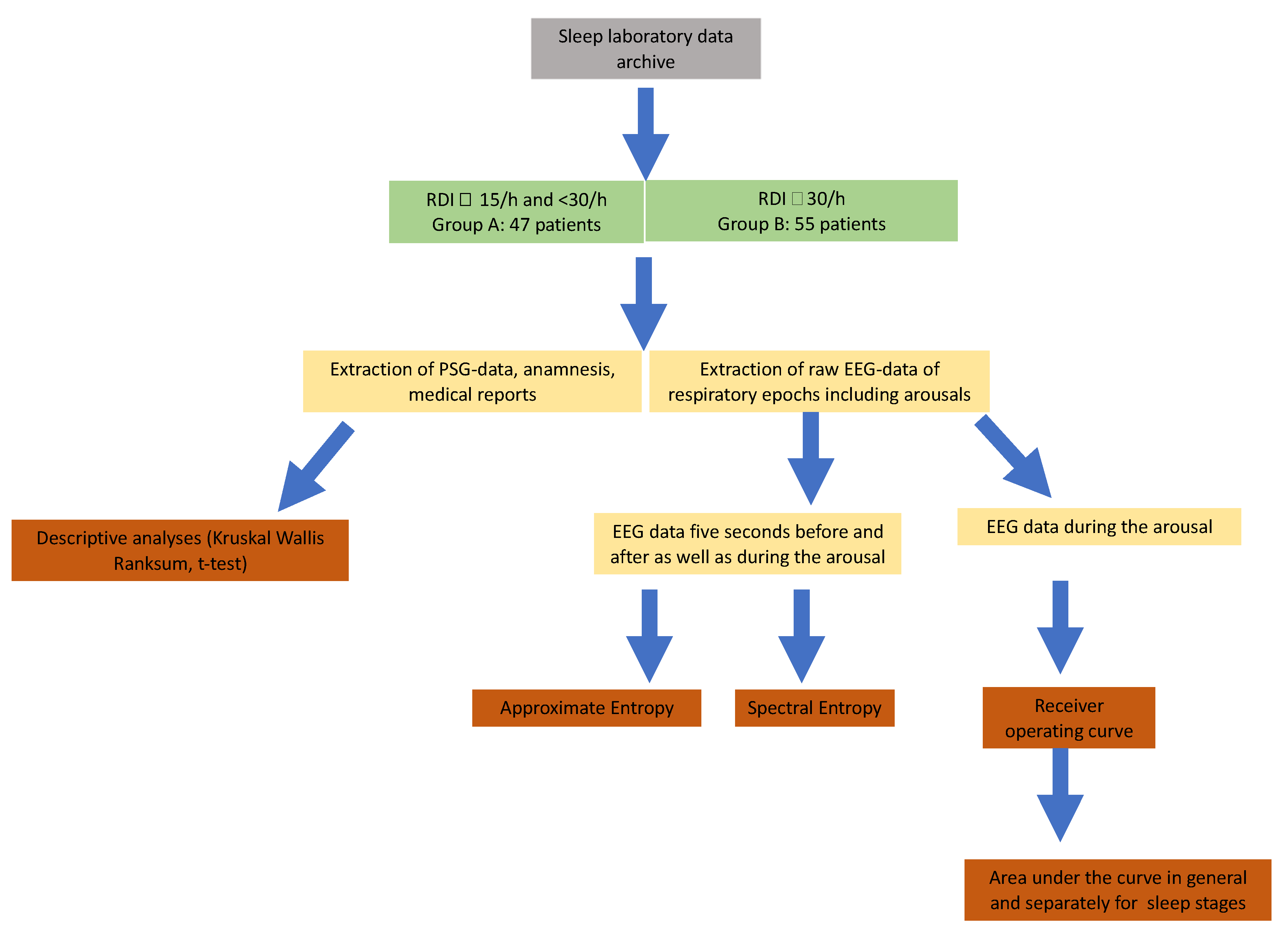
| All Participants | Group A (Moderate OSA) | Group B (Severe OSA) | p Value | |
|---|---|---|---|---|
| N (F/M) | 102 (32/70) | 47 (20/27) | 55 (12/43) | |
| Age range (mean) years | 27–86 (51.6 ± 12.0) | 28–70 (50.17 ± 10.8) | 27–86 (52.9 ± 12.9) | 0.247 |
| BMI range (mean) kg/m2 | 19.6–46.6 (31.3 ± 5.3) | 20.9–46.5 (30.9 ± 5.6) | 19.5–43.2 (31.7 ± 5.1) | 0.289 |
| ESS score range (mean) points | 2–21 (9.9 ± 4.9) | 3–19 (9.8 ± 4.7) | 2–21 (10.2 ± 5.2) | 0.398 |
| TST range (mean) minutes | 167–491 (348.5 ± 61.5) | 203–49 (362.3 ± 54.2) | 167–458 (336.9 ± 65.4) | 0.068 |
| Sleep efficiency range (mean) % | 47.9–98.2 (83.4 ± 11.1) | 62.6–98.2 (85.7 ± 8.6) | 47.9–98.2 (81.5 ± 12.7) | 0.145 |
| ODS range (mean) per hour | 1.4–97.5 (27.7 ± 23.0) | 1.4–29.8 (12.8 ± 7.3) | 8.6–97.5 (40.4 ± 24.2) | <0.001 * |
| T90 range (mean) % | 0–68.5 (6.6 ± 11.9) | 0–27.6 (2.7 ± 5.1) | 0–68.5 (10.0 ± 14.8) | 0.001 * |
| ODS-REM range (mean) % | 77–98 (93 ± 3.4) | 88–98 (94.2 ± 2.2) | 77–96 (92 ± 4.0) | 0.001 * |
| ODS-NREM range (mean) % | 86–97 (93.5 ± 1.9) | 91–97 (94.2 ± 1.7) | 86–97 (93.0 ± 2.0) | 0.004 * |
| ArI range (mean) per hour | 4.3–93.4 (30.8 ± 16.5) | 4.3–42.5 (22.1 ± 7.4) | 9.9–93.4 (38.2 ± 18.5) | <0.001 * |
| RCA range (mean) | 7–395 (99 ± 72.4) | 13–151 (67.3 ± 29.5) | 7–395 (126 ± 86.2) | <0.001 * |
Disclaimer/Publisher’s Note: The statements, opinions and data contained in all publications are solely those of the individual author(s) and contributor(s) and not of MDPI and/or the editor(s). MDPI and/or the editor(s) disclaim responsibility for any injury to people or property resulting from any ideas, methods, instructions or products referred to in the content. |
© 2022 by the authors. Licensee MDPI, Basel, Switzerland. This article is an open access article distributed under the terms and conditions of the Creative Commons Attribution (CC BY) license (https://creativecommons.org/licenses/by/4.0/).
Share and Cite
Bahr-Hamm, K.; Koirala, N.; Hanif, M.; Gouveris, H.; Muthuraman, M. Sensorimotor Cortical Activity during Respiratory Arousals in Obstructive Sleep Apnea. Int. J. Mol. Sci. 2023, 24, 47. https://doi.org/10.3390/ijms24010047
Bahr-Hamm K, Koirala N, Hanif M, Gouveris H, Muthuraman M. Sensorimotor Cortical Activity during Respiratory Arousals in Obstructive Sleep Apnea. International Journal of Molecular Sciences. 2023; 24(1):47. https://doi.org/10.3390/ijms24010047
Chicago/Turabian StyleBahr-Hamm, Katharina, Nabin Koirala, Marsha Hanif, Haralampos Gouveris, and Muthuraman Muthuraman. 2023. "Sensorimotor Cortical Activity during Respiratory Arousals in Obstructive Sleep Apnea" International Journal of Molecular Sciences 24, no. 1: 47. https://doi.org/10.3390/ijms24010047
APA StyleBahr-Hamm, K., Koirala, N., Hanif, M., Gouveris, H., & Muthuraman, M. (2023). Sensorimotor Cortical Activity during Respiratory Arousals in Obstructive Sleep Apnea. International Journal of Molecular Sciences, 24(1), 47. https://doi.org/10.3390/ijms24010047








